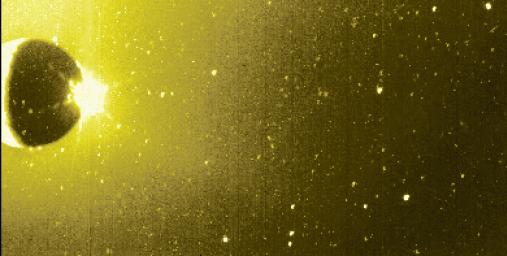Io’s Sodium Cloud (Green-yellow Filter)
Caption:
This image of Jupiter's moon Io and its surrounding sky is shown in false color. North is at the top, and east is to the right. Most of Io's visible surface is in shadow, though one can see part of a white crescent on its western side. This crescent is being illuminated mostly by "Jupitershine" (i.e. sunlight reflected off Jupiter).
The striking burst of white light near Io's eastern equatorial edge is sunlight being scattered by the plume of the volcano Prometheus. Prometheus lies just beyond the visible edge of the moon on Io's far side. Its plume extends about 100 kilometers above the surface, and is being hit by sunlight just a little east of Io's eastern edge.
Scattered light from Prometheus' plume and Io's lit crescent also contribute to the diffuse yellowish emission which appears throughout much of the sky. However, much of this emission comes from Io's Sodium Cloud: sodium atoms within Io's extensive material halo are scattering sunlight at the yellow wavelength of about 589 nanometers.
This image was taken at 5 hours 30 minutes Universal Time on Nov. 9, 1996 through the green-yellow filter of the solid state imaging (CCD) system aboard NASA's Galileo spacecraft. Galileo was then in Jupiter's shadow, and located about 2.3 million kilometers (about 32 Jovian radii) from both Jupiter and Io.
Background Info:
The Jet Propulsion Laboratory, Pasadena, CA, manages the mission for NASA's Office of Space Science, Washington D.C. This image and other images and data received from Galileo are posted on the World Wide Web Galileo mission home page at:
http://www.jpl.nasa.gov/galileo/sepo
.
Cataloging Keywords:
| Name |
Value |
Additional Values |
| Target |
Io |
Jupiter |
| System |
Jupiter |
|
| Target Type |
Satellite |
Planet |
| Mission |
Galileo |
|
| Instrument Host |
Galileo Orbiter |
|
| Host Type |
Orbiter |
|
| Instrument |
Solid-State Imaging (SSI) |
|
| Detector |
|
|
| Extra Keywords |
Color, Plume, Shadow, Volcano |
| Acquisition Date |
|
| Release Date |
1997-12-18 |
| Date in Caption |
1996-11-09 |
|
| Image Credit |
NASA/JPL |
| Source |
photojournal.jpl.nasa.gov/catalog/PIA00593 |
| Identifier |
PIA00593 |

 Planetary Data System
Planetary Data System
